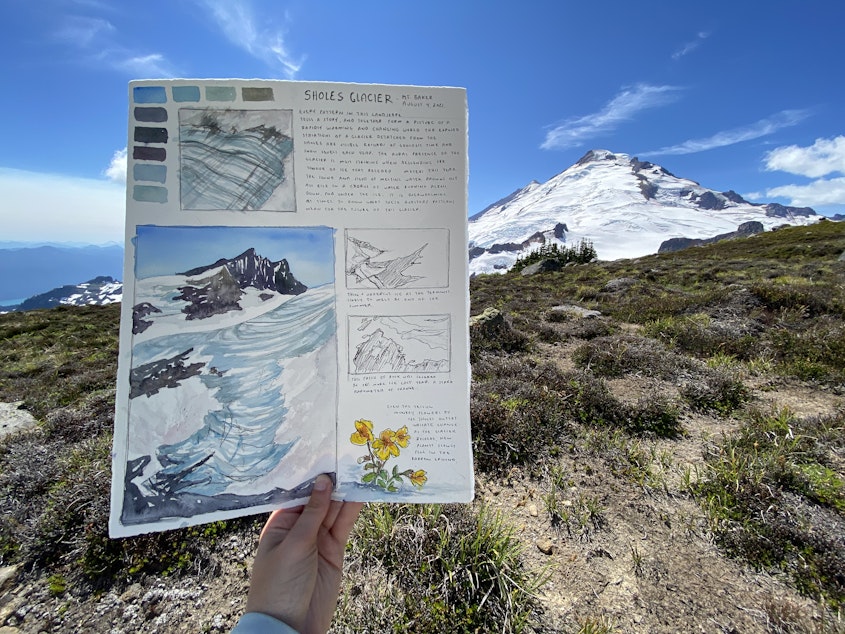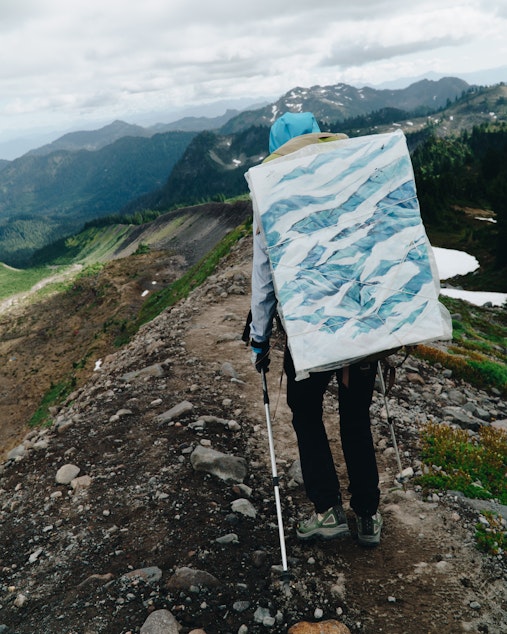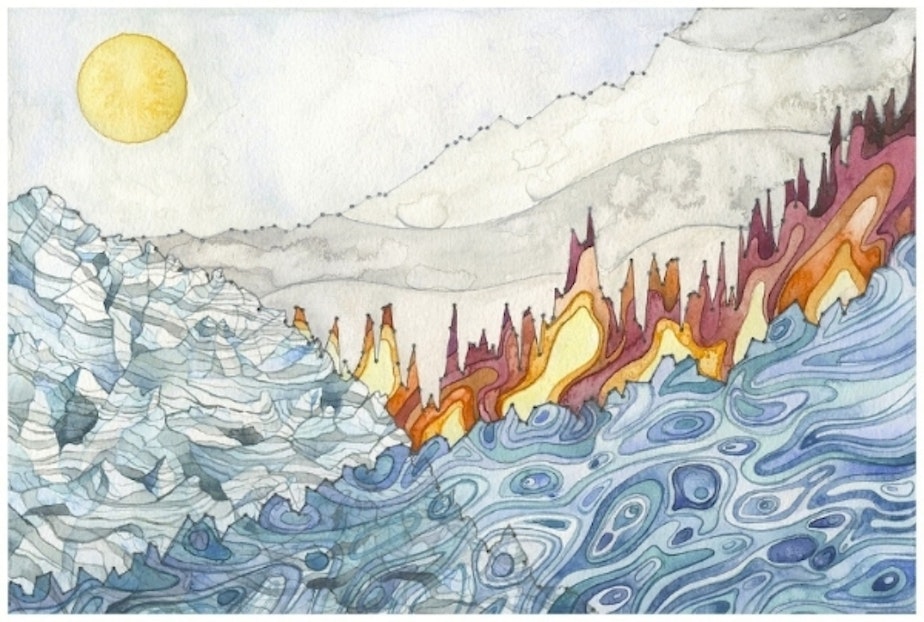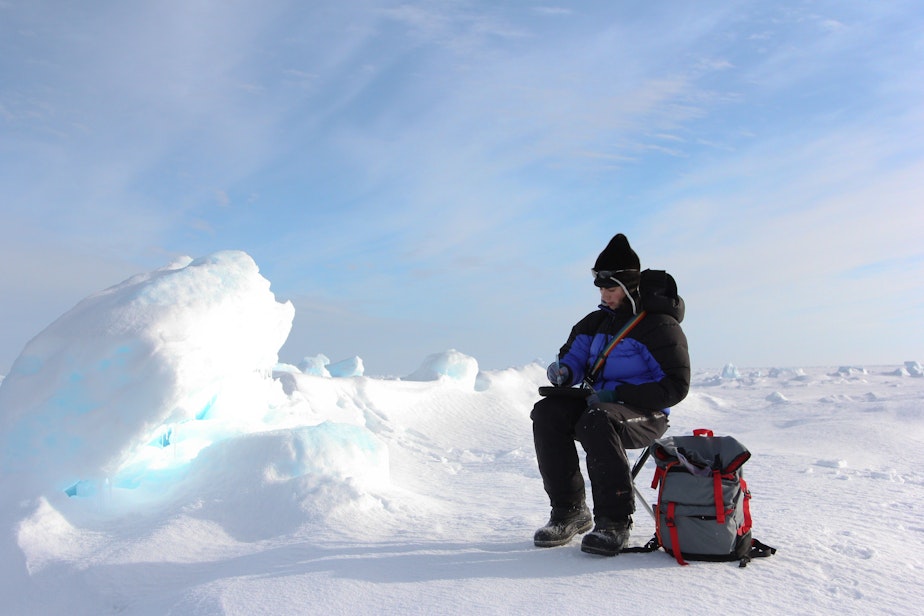These artists climb mountains to help document climate change

Washington state's glacier fields in the Olympic Mountains and the Cascade Range are melting by significant margins. In order to study those glaciers, researchers hike back into some of the most remote outreaches of our wilderness.
But they're rarely going alone. Aside from research teams, these expeditions frequently include artists, and through painting, sketching and other media, these artists are working with scientists to communicate science in a way that isn't reliant on numbers or heady scientific explanations.
Soundside Producer Alec Cowan spoke with a few local expeditionary artists — Claire Giordano, Maria-Coryell Martin and Jill Pelto — about what it's like to create beautiful artwork from a changing world.
Claire Giordano

Claire Giordano is an expeditionary artist and educator. Throughout her travels she's seen change in the HJ Andrews Experimental Forest, in Oregon, glacial loss in the North Cascades, and has taught others on how to find wild places and create art out of their changing landscapes.
Sponsored
Frequently, the act of painting and sketching on mountaintops and in dry canyons changes the artwork itself.
"I feel like every painting created outside is a conversation with place," Giordano said. "Up here in Washington, when it's nice and decently humid, even on a nice warm day, my paints will behave with some regularity, right, and I'll get these incredible patterns. But if I might be painting in the desert, or if a wind picks up or if I'm too close to the glacier, and it's really cold, my paints will take longer to dry, and I'll just get different patterns that appear that are almost impossible to create back in the studio. So, that piece is really kind of co-created with place."
Frequently, expeditionary artists are traveling with scientists as they measure shifts in the environment. Artists and scientists work together to communicate the same science, just through different means. Giordano recounts a time she traveled to the North Cascades with Dr. Mauri Pelto, a glaciologist who's studied the region for decades.
"My hope is that, as you're working alongside them, is that the paintings I create become very, very different," Giordano said. "They become the reflections of both what I'm experiencing and what they're sharing with me and showing me and teaching me."
You can find more of Giordano's work here.
Sponsored
Jill Pelto

Jill Pelto is a climate change artist and science communicator.
"That means sharing information or stories about science in ways that are more accessible, or maybe they can just reach different audiences than the more traditional ways of sharing science," Pelto said.
Sponsored
Pelto melds graphical precision with the colorful blurring of paints. She takes real data, usually packaged on an X and Y axis from a spreadsheet, and creates an illustrative scene from the numbers. For example, her work "Landscapes of Change" plots increases in rising sea levels and wildfire acreage against decreasing glacier ice.
"I'm trying to use that actual information of that data to help tell a more literal, visual story of why this graph and this simple line matters," Pelto said.
So far her work has brought to life changes in salmon population, reforestation and landscape loss. In 2020, she collaborated with Claire Giordano on a Time magazine cover depicting the past and future landscapes of our natural world.
"Looking at my art, maybe you can [change someone's perspective on climate change], perhaps a little easier than just looking at a graph on its own and trying to figure out what the story of that graph really is, and why it really matters," Pelto said.
You can find more of Pelto's work here.
Sponsored
Maria Coryell-Martin

"I really believe fundamentally in art as a tool versus a talent, that is accessible for everyone to get out and explore your world and see things a little bit more deeply, maybe from a different perspective and get curious about it," said Maria Coryell-Martin, an expeditionary artist based in Port Townsend, Washington. "And I think there's this wonderful link between art and science from that observation and curiosity."
Coryell-Martin has traveled the world, observing narwhals in Greenland with Kristin Laidre and bear populations with George Divoky on Cooper Island, off the North Alaskan coast.
Sponsored
"I think artists and scientists are both going out to observe things deeply and working to interpret them and share their understandings," Coryell-Martin said. "And so there's a bit of have some shared love for the subject matter and the process and I feel that I share that with scientists."
You can find more of Coryell-Martin's work here.




